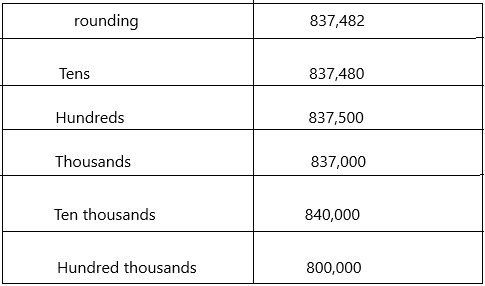By accessing our 180 Days of Math for Fifth Grade Answers Key Day 178 regularly, students can get better problem-solving skills.
180 Days of Math for Fifth Grade Answers Key Day 178
Directions: Solve each problem.
Question 1.
Subtract 78 from 143.
Answer:
Subtraction is one of the four basic arithmetic operations in mathematics. We can observe the applications of subtraction in our everyday life in different situations. For example, when we purchase fruits and vegetables for a certain amount of money say Rs. 200 and we have given an Rs. 500 note to the vendor. Now, the vendor returns the excess amount by performing subtraction such as 500 – 200 = 300. Then, the vendor will return Rs. 300.
Now we need to calculate the above-given question:
we need to subtract 78 from 143.

143 = Minuend; 78 = Subtrahend; 65 = Difference
Therefore, the answer is 65.
Question 2.

Answer:
In mathematics, multiplication is a method of finding the product of two or more numbers. It is one of the basic arithmetic operations, that we use in everyday life. The major application we can see in multiplication tables.
In arithmetic, the multiplication of two numbers represents the repeated addition of one number with respect to another. These numbers can be whole numbers, natural numbers, integers, fractions, etc. If m is multiplied by n, then it means either m is added to itself ‘n’ number of times or vice versa.
The formula for multiplication:
The multiplication formula is given by:
Multiplier × Multiplicand = Product
– The multiplicand is the total number of objects in each group
– A multiplier is the number of equal groups
– Product is the result of multiplication of multiplier and multiplicand
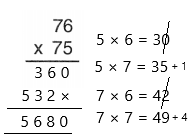
Therefore, 76×75 is equal to 5680.
Question 3.
453 ÷ 25 = __________
Answer:
The division is breaking a number into an equal number of parts. The division is an arithmetic operation used in Maths. It splits a given number of items into different groups.
There are a number of signs that people may use to indicate division. The most common one is ÷, but the backslash / and a horizontal line (-) is also used in the form of Fraction, where a Numerator is written on the top and a Denominator on the bottom.
The division formula is:
Dividend ÷ Divisor = Quotient (or) Dividend/Divisor=quotient
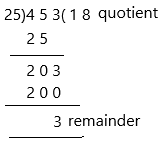
Therefore, 453 ÷ 25 = 18
Question 4.
How many digits are in 593,001?
Answer:
Place value in Maths describes the position or place of a digit in a number. Each digit has a place in a number. When we represent the number in general form, the position of each digit will be expanded. Those positions start from a unit place or we also call it one’s position. The order of place value of digits of a number of right to left is units, tens, hundreds, thousands, ten thousand, a hundred thousand, and so on.
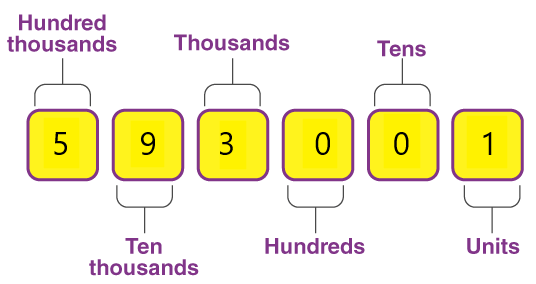
There are six digits in the number 593,001.
1 is in the unit’s place.
0 is in the tens place
0 is in the hundreds place
3 is in the thousands place
9 is in the ten thousand place
5 is in the hundred thousand places.
Question 5.
Write 90% as a fraction.
Answer:
To convert 90% to a fraction follow these steps:
Step 1: Write down the per cent divided by 100 like this
90%=90/100
Step 2: Multiply both top and bottom by 10 for every number after the decimal point. As 90 is an integer, we don’t have numbers after the decimal point. So, we just go to step 3.
Step 3: simplify (or reduce) the above fraction by dividing both numerator and denominator by the GCD (greatest common divisor) between them. In this case, GCD(90,100) = 10. So,
(90 ÷ 10)/(100 ÷ 10)
 90
90
We can write as 90% as 9/10.
Question 6.
20 + 20 ÷ 4 = ____________
Answer:
The above-given mathematical computation can be written as:
=20+(20÷4)
=20+(5)
=25
Therefore, the answer is 25.
Question 7.

Answer: 32
Explanation:
How 32?
– First, divide 4 and 128 then we get quotient 32
– Now once multiply 4 with 32 then we get 128. If we check like this then we can easily find out the answer.
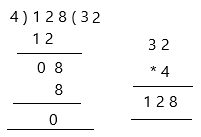
Question 8.
Calculate the volume of a rectangular prism that is 4 m by 2 m by 3 m.
Answer:
In mathematics, the prism is a three-dimensional figure in which the faces of the solid are rectangles. It has six rectangular faces. The rectangular prism is also known as the cuboid. It has a rectangular cross-section. The opposite faces of the rectangular prism are of equal measure. If the length, width, and height are measures of the rectangular prism, then the volume of the rectangular prism is given by the formula,
The volume of the rectangular prism, V = Length × Width × Height cubic units
The above-given units: 4m, 2m, 3m
V=4×2×3
V=24 cube units.
Question 9.
True or false?
The diameter of a circle is three times its radius.
Answer: False
The diameter of a circle is four its radius.
The diameter of a circle is calculated as D=2R
where R is the radius of the circle.
Question 10.
How much more did it rain in June than in May?

Answer:
The millimetres of rain in june=60
The millimetres of rain in may=25
The millimetres of rain in June than in may=X
X=60-25
X=35
Therefore, 35 millimetres more rain in June than in May.
Question 11.
What is the probability of rolling 3 on a 6-sided die?
Answer:
Probability: Probability means Possibility. It states how likely an event is about to happen. The probability of an event can exist only between 0 and 1 where 0 indicates that event is not going to happen i.e. Impossibility and 1 indicates that it is going to happen for sure i.e. Certainty.
The higher or lesser the probability of an event, the more likely it is that the event will occur or not respectively. For example – An unbiased coin is tossed once. So the total number of outcomes can be 2 only i.e. either “heads” or “tails”. The probability of both outcomes is equal i.e. 50% or 1/2.
So, the probability of an event is Favorable outcomes/Total number of outcomes. It is denoted with the parenthesis i.e. P(Event).
P(Event)=N(Favourable outcomes)/N(Total outcomes)
When 6-sided dice are rolled then total outcomes are 6 and
Sample space is [1, 2, 3, 4, 5, 6]
Total outcomes=6
Favourable outcomes=1
Probability of getting a 3 on 6-sided dice = favourable outcomes/total outcomes
P(getting a 3)=1/6
Therefore, P(3)=1/6
Question 12.
Complete the chart by rounding the number 837,482 to the specified place.
| Ten | |
| Hundred | |
| Thousand | |
| Ten thousand | |
| Hundred thousand |
Answer:
Rounding a number means the process of making a number simpler such that its value remains close to what it was. The result obtained after rounding off a number is less accurate, but easier to use. While rounding a number, we consider the place value of digits in a number.
There are some basic rules that need to be followed for rounding numbers.
– We first need to know what our rounding digit is. This digit is the one that will ultimately be affected.
– After this, we need to check the digit to the right of this place which will decide the fate of the rounding digit.
– If the digit to the right is less than 5, we do not change the rounding digit. However, all the digits to the right of the rounding digit are changed to 0.
– If the digit to the right is 5 or more than 5, we increase the rounding digit by 1, and all the digits to the right of the rounding digit are changed to 0.
Rounding the number nearest to ten: Rounding numbers to the nearest ten means we need to check the digit to the right of the tens place, that is the one’s place.
The above-given number is 837,482. Check the number in one’s place, the number in the one’s place is less than 5 so the number in the tens place won’t change and the number in the one’s place becomes zero. Thus, the number is 837,480
– Likewise, we need to round the numbers in hundreds, thousands, ten thousand, hundred thousands.
